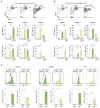E and Id proteins influence invariant NKT cell sublineage differentiation and proliferation
- PMID: 24470501
- PMCID: PMC3943952
- DOI: 10.4049/jimmunol.1302904
E and Id proteins influence invariant NKT cell sublineage differentiation and proliferation
Abstract
Disease outcome is known to be influenced by defined subsets of invariant NKT (iNKT) cells residing in distinct locations within peripheral tissue. However, the factors governing the development of these unique iNKT sublineages during thymic development are unknown. In this study we explored the mechanism by which E protein transcription factors and their negative regulators, the Id proteins, control the development of iNKT sublineages after positive selection. We found that E proteins directly bound the promyelocytic leukemia zinc finger (PLZF) promoter and were required for expression of this lineage-defining transcription factor and for the maturation and expansion of thymic iNKT cells. Moreover, expression of the negative regulators of E proteins, Id2 and Id3, defined distinct iNKT cell sublineages. Id3 was expressed in PLZF(high) NKT2 cells and loss of Id3 allowed for increased thymic iNKT cell expansion and abundance of the PLZF(+) NKT2 sublineage. Id2 was expressed in T-BET(+) NKT1 cells, and both Id proteins were required for the formation of this sublineage. Thus, we provide insight into E and Id protein regulation of iNKT cell proliferation and differentiation to specific sublineages during development in the thymus.
Figures






Similar articles
-
Essential functions for ID proteins at multiple checkpoints in invariant NKT cell development.J Immunol. 2013 Dec 15;191(12):5973-83. doi: 10.4049/jimmunol.1301521. Epub 2013 Nov 15. J Immunol. 2013. PMID: 24244015 Free PMC article.
-
Combined deletion of Id2 and Id3 genes reveals multiple roles for E proteins in invariant NKT cell development and expansion.J Immunol. 2013 Nov 15;191(10):5052-64. doi: 10.4049/jimmunol.1301252. Epub 2013 Oct 11. J Immunol. 2013. PMID: 24123680 Free PMC article.
-
Id3 Restricts γδ NKT Cell Expansion by Controlling Egr2 and c-Myc Activity.J Immunol. 2018 Sep 1;201(5):1452-1459. doi: 10.4049/jimmunol.1800106. Epub 2018 Jul 16. J Immunol. 2018. PMID: 30012846 Free PMC article.
-
Lineage Differentiation Program of Invariant Natural Killer T Cells.Immune Netw. 2017 Dec;17(6):365-377. doi: 10.4110/in.2017.17.6.365. Epub 2017 Nov 27. Immune Netw. 2017. PMID: 29302250 Free PMC article. Review.
-
New Genetically Manipulated Mice Provide Insights Into the Development and Physiological Functions of Invariant Natural Killer T Cells.Front Immunol. 2018 Jun 14;9:1294. doi: 10.3389/fimmu.2018.01294. eCollection 2018. Front Immunol. 2018. PMID: 29963043 Free PMC article. Review.
Cited by
-
Zbtb16 (PLZF) is stably suppressed and not inducible in non-innate T cells via T cell receptor-mediated signaling.Sci Rep. 2015 Jul 16;5:12113. doi: 10.1038/srep12113. Sci Rep. 2015. PMID: 26178856 Free PMC article.
-
Genetic Analysis of iNKT Cell Development and Function.Methods Mol Biol. 2021;2388:1-12. doi: 10.1007/978-1-0716-1775-5_1. Methods Mol Biol. 2021. PMID: 34524657 Review.
-
Orchestration of invariant natural killer T cell development by E and Id proteins.Crit Rev Immunol. 2015;35(1):33-48. doi: 10.1615/critrevimmunol.2015012207. Crit Rev Immunol. 2015. PMID: 25746046 Free PMC article. Review.
-
The transcription factor lymphoid enhancer factor 1 controls invariant natural killer T cell expansion and Th2-type effector differentiation.J Exp Med. 2015 May 4;212(5):793-807. doi: 10.1084/jem.20141849. Epub 2015 Apr 20. J Exp Med. 2015. PMID: 25897173 Free PMC article.
-
Development of mucosal-associated invariant T cells.Immunol Cell Biol. 2018 Jul;96(6):598-606. doi: 10.1111/imcb.12039. Epub 2018 Apr 24. Immunol Cell Biol. 2018. PMID: 29569752 Free PMC article. Review.
References
-
- Brennan PJ, Brigl M, Brenner MB. Invariant natural killer T cells: an innate activation scheme linked to diverse effector functions. Nat Rev Immunol. 2013;13:101–117. - PubMed
-
- Bendelac A, Savage PB, Teyton L. The biology of NKT cells. Annu Rev Immunol. 2007;25:297–336. - PubMed
-
- Berzins SP, Smyth MJ, Baxter AG. Presumed guilty: natural killer T cell defects and human disease. Nat Rev Immunol. 2011;11:131–142. - PubMed
-
- Montoya CJ, Pollard D, Martinson J, Kumari K, Wasserfall C, Mulder CB, Rugeles MT, Atkinson MA, Landay AL, Wilson SB. Characterization of human invariant natural killer T subsets in health and disease using a novel invariant natural killer T cell-clonotypic monoclonal antibody, 6B11. Immunology. 2007;122:1–14. - PMC - PubMed
Publication types
MeSH terms
Substances
Grants and funding
LinkOut - more resources
Full Text Sources
Other Literature Sources
Molecular Biology Databases

